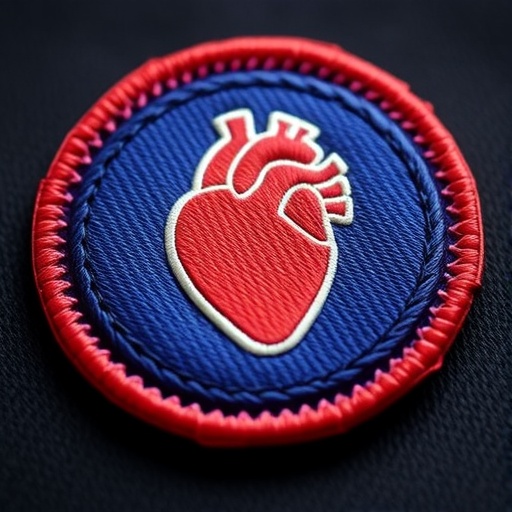In a groundbreaking advancement poised to revolutionize post-myocardial infarction therapy, engineers at MIT have devised a novel, flexible drug-delivery patch designed to be applied directly to the heart following a heart attack. This innovation not only promises to accelerate cardiac tissue healing but also addresses one of the most critical challenges in cardiovascular medicine: precise, time-controlled drug administration that aligns seamlessly with the heart’s natural regenerative phases.
Heart attacks result in irreversible damage to cardiac tissue since the mammalian heart has a limited capacity to regenerate after injury. Traditional interventions such as bypass surgery primarily restore blood flow but do not repair the damaged myocardium. Recognizing this therapeutic gap, the MIT team engineered a sophisticated patch capable of delivering multiple therapeutic agents sequentially, timed to the biological demands of the post-infarction healing process. This approach harnesses temporal precision in drug release, a feature not present in conventional systemic or immediate-release therapies.
The technology hinges on the use of micro-particles encapsulated with active drugs housed within a flexible hydrogel matrix. These micro-particles are crafted from poly(lactic-co-glycolic acid) (PLGA), a biodegradable polymer approved by regulatory agencies and commonly used in medical applications. By carefully modulating the molecular weight of the polymers forming the microcapsule lids, researchers can fine-tune the degradation rates of these particles, orchestrating drug release at predetermined intervals. This programmability enables the staggered delivery of three distinct compounds within a therapeutic timeline spanning two weeks.
Initially, during days 1 through 3 post-implantation, the patch releases neuregulin-1, a potent growth factor known for its cardioprotective properties and ability to prevent cardiomyocyte apoptosis. Subsequently, in the therapeutic window of days 7 to 9, vascular endothelial growth factor (VEGF) is released to stimulate angiogenesis, promoting the formation of new blood vessels to revascularize ischemic zones of the heart. Finally, between days 12 and 14, the small molecule GW788388 is deployed to inhibit the TGF-beta signaling pathway, effectively mitigating fibrosis and scar tissue formation that can otherwise stiffen cardiac walls and impair function.
Dr. Ana Jaklenec, a principal investigator at MIT’s Koch Institute for Integrative Cancer Research, underscores the significance of this methodical approach: “Heart tissue regeneration requires a precisely timed sequence of molecular signals. Our patch mimics this natural progression, delivering therapeutic agents in a way that mirrors the healing cascade of a healthy myocardium.” The patch itself is fabricated from biocompatible hydrogels, specifically alginate and poly(ethylene glycol) diacrylate (PEGDA), materials that confer flexibility and biodegradability, ensuring the patch conforms to the dynamic movements of the beating heart without compromising mechanical integrity.
To evaluate the efficacy of the patch, the researchers conducted sophisticated in vitro experiments utilizing three-dimensional cardiac spheroids composed of cardiomyocytes derived from induced pluripotent stem cells, alongside endothelial cells and human ventricular cardiac fibroblasts. Subjecting these spheroids to hypoxic conditions simulated ischemic injury akin to a heart attack. Application of the drug-laden patch resulted in enhanced vascular network formation, increased cardiomyocyte survival, and a marked reduction in fibrotic deposition, collectively indicating a robust pro-regenerative effect.
Translating these promising in vitro findings, preclinical trials in a rat myocardial infarction model demonstrated profound therapeutic benefits. Animals treated with the programmed patch exhibited a remarkable 50% reduction in damaged myocardial tissue relative to untreated controls. Furthermore, survival rates improved by 33%, and cardiac output—quantified using echocardiography—showed significant enhancement compared to conventional drug administration routes such as intravenous injection. Notably, the patch degraded completely over the span of a year, becoming a thin, inert layer without impeding the heart’s mechanical function or rhythm.
The ingenuity of this drug-delivery system lies in its ability to integrate pharmacodynamics and biomaterials science, yielding a platform that is “programmed” to administer therapy in discrete, optimal phases of heart tissue repair. Robert Langer, the David H. Koch Institute Professor and one of the study’s senior authors, emphasizes this synergy, stating, “Our platform exemplifies how controlled drug delivery combined with advanced biomaterials can open new frontiers in treating complex diseases like myocardial infarction.”
While two of the therapeutics used—neuregulin-1 and VEGF—have been explored in human clinical trials for cardiovascular diseases, GW788388’s application remains investigational and confined to preclinical models. Encouraged by the patch’s efficacy and versatility, the team plans to further test the technology in larger animal models, moving closer to clinical translation. They also envision adaptations of this technology for less invasive delivery methods, such as incorporating the microparticles into arterial stents, which could be deployed catheter-based to provide phased drug release internally within coronary vessels.
The MIT researchers view the patch as a transformative approach that equips surgeons with a customizable, programmable tool to enhance myocardial healing during routine cardiac surgeries. The convergence of precision drug delivery, biodegradable biomaterials, and regenerative biology embodied in this patch may herald a new era in cardiovascular therapeutics—offering heart attack patients a tangible path toward restoring function and preventing the debilitating sequelae of cardiac injury.
Subject of Research: Animals
Article Title: TIMED (Temporal Intervention with Micro-Particle Encapsulation and Delivery): A Programmed Release System for Post-Myocardial Infarction Therapy
News Publication Date: 4-Nov-2025
Web References: http://dx.doi.org/10.1016/j.celbio.2025.100249
Image Credits: MIT
Keywords: Drug delivery, Pharmaceuticals, Drug delivery systems, Targeted drug delivery, Health and medicine, Cardiovascular disorders, Vascular diseases, Myocardial infarction
Tags: biodegradable polymers in medicinecardiac tissue repair advancementscontrolled drug administrationdrug-delivery technology for heartflexible hydrogel drug releaseheart healing patchmicro-particle drug delivery systemsMIT cardiovascular innovationmyocardial infarction therapypost-heart attack treatmentregenerative medicine for hearttemporal precision in drug therapies





